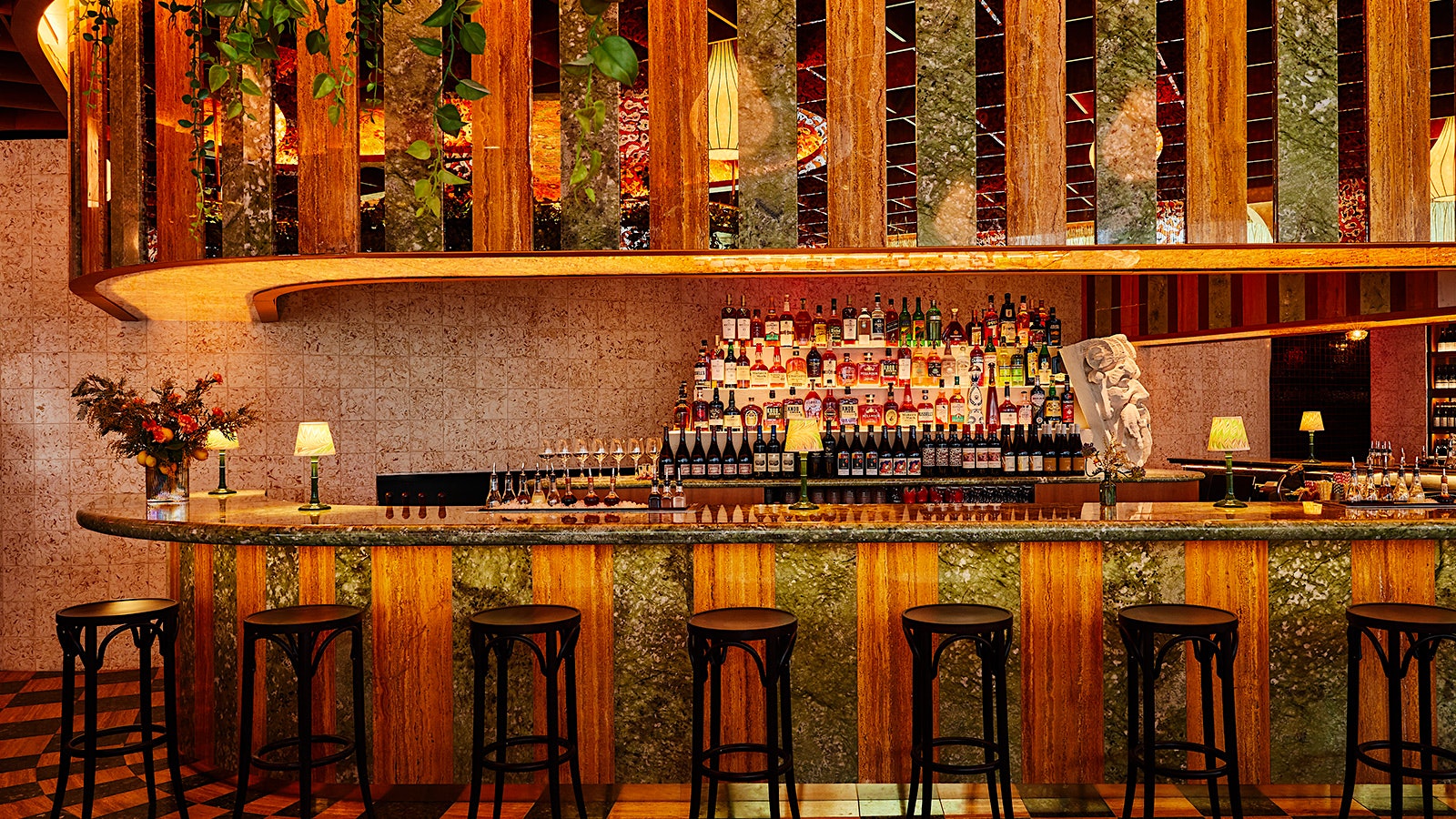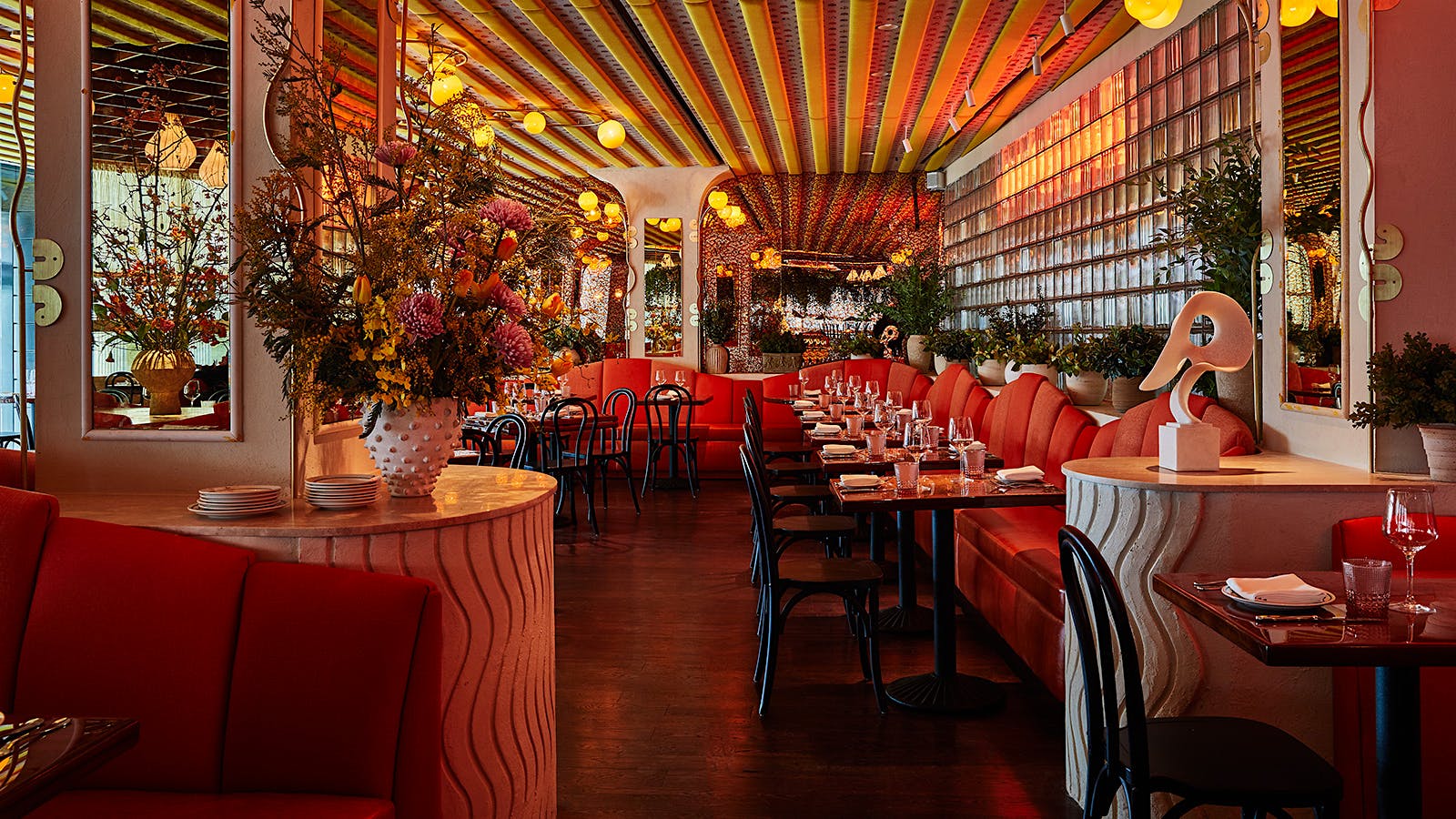Products You May Like
On Feb. 17, the Quality Branded restaurant group opened Bad Roman at the Deutsch Bank Center (formerly the Time Warner Center) in Manhattan’s Columbus Circle. With picturesque views over Central Park, the restaurant occupies the space formerly used by chef Marc Murphy’s Landmarc, which closed in 2019. It joins a celebrated portfolio, including sibling restaurants like Wine Spectator Best of Award of Excellence winner Quality Italian in Denver and the original Smith & Wollensky steak house location in New York.
True to its name, Bad Roman’s menu draws heavily from Italian cuisine, but with a twist: It’s influenced by Italian-inspired cooking traditions from across the globe, like that of New York’s Little Italy neighborhood. The results are small plates like roasted garlic babka with macaroni cups, Hamachi crudo with Sicilian pistachios and a wedge salad with soppressata; mains include scallops piccata, “Tuscan” fried chicken and a wide selection of other dishes from chef Nick Gaube and his team.
“I believe [Bad Roman] is offering a new and different type of Italian dining to the New York dining scene,” Gaube told Wine Spectator via email. “We’re not trying to be an authentic Italian restaurant—we’re playing off of all different offshoots of Italian cuisine to make something unique, fun and different.”
Wine director Meng Chiang oversees a program of about 300 labels and a cellar of 3,500 bottles. “In following the menu, the wine list is Italian-American, slightly off-script, slightly off the beaten path, with surprises in unusual locations,” said Chiang. “After all, discovery is the most fun part of drinking wine!” Occupying about 65 percent of the ever-changing list, Italy is, indeed, the star, with selections from up and down the boot. This includes leading wineries like Tuscany’s Avignonesi, Sicily’s Fessina and Piedmont’s Paolo Scavino.

Along with additional wines from the U.S. and France, there are about 8 large-format bottles, a selection of amphorae-aged reds and some 22 wines by the glass. Guests can also enjoy Italian-inspired cocktails like the Tequila Granita, Martini Pepperoncini and Roman Cocktail (rye, Campari and hazelnuts).
“We want to have a fun, engaging, informal atmosphere, with serious food and beverages. There’s no reason they cannot coexist,” said Chiang. “Just because we serve a grappa in a shot glass with a model race car attached doesn’t mean it’s not great grappa!”
Design firm GRT Architects created a lively, fun setting for Bad Roman’s guests, with vines hanging from the rafters, lighting fixtures made from locally blown glass and a colorful set of orange banquettes, as well as eye-catching tilework and mosaics. In addition to the main dining room, two private rooms are available for parties of up to 40 guests each.—C.D.
Alum of Georgie by Curtis Stone Opens Quarter Acre in Dallas

Whether they call it Lower Greenville or opt for the increasingly fashionable superlative, Lowest Greenville, visitors to the happening southern stretch of Dallas’ Greenville Avenue face two challenges: deciding where to eat and finding a place to park. We can’t help you with the latter, but a new restaurant promises to become a go-to for wine lovers seeking a good meal in the historic neighborhood.
Located in the space formerly occupied by Rapscallion, Quarter Acre is the creation of chef and owner Toby Archibald, an alumnus of Wine Spectator Best of Award of Excellence winners Georgie by Curtis Stone and Café Boulud in Toronto. The restaurant, which opened in January, combines upscale dining with the hominess of a neighborhood joint, and pays homage to Archibald’s New Zealand roots while embracing an international, modern flair.
Archibald’s menu spotlights seafood from New Zealand and Australia with dishes such as kingfish ceviche, parmesan-buttered grouper and hot-smoked Glory Bay salmon. Other standouts include the Instagram-worthy smoked beef tartare and beef short rib with roasted mushrooms, as well as charred carrots with spiced yogurt, maple gastrique and winter garden herbs. Don’t forget desserts, which include sticky toffee pudding and jackfruit mille-feuille.
Overseen by Archibald and beverage director Jacob Fergus (formerly assistant wine director at downtown Dallas’ Monarch Restaurant), the wine list highlights off-the-beaten-path New World bottlings alongside plenty of familiar options. “The collection offers a wide array of international wines with an emphasis on … New Zealand and Australia,” Fergus told Wine Spectator. “These selections come not only from chef Archibald’s desire to share elements of his home country, but also from the restaurant’s enthusiasm to showcase regions that are often neglected by sommeliers.”
Standout producers include Mollydooker and Penfolds. Beyond Australia and New Zealand, the list features wines from noteworthy wineries like California’s Au Bon Climat and Rudd and Barolo’s Paolo Scavino. Great values are abundant across the list, with many options offered at $100 or less. There are also plenty of splurge-worthy bottles, including Château Palmer’s Margaux. Altogether, the list rewards vinous adventuring with everything from Australian sparklers to local Texas wines. “I believe that bottles from Oceania remain some of the best-kept secrets of New World wine, and that there is a hunger from guests to try something different,” said Fergus.
Quarter Acre is open for evening drinks and dinner from Tuesday to Saturday; a patio will open in the spring.—K.M.
Voltaggio Brothers Debut Vulcania in Mammoth Lakes

Days before chefs Michael and Bryan Voltaggio—owners of Wine Spectator Best of Award of Excellence winner Voltaggio Brothers Steak House in Maryland—were to open Vulcania, their new Italian-American concept in Mammoth Lakes, blizzard conditions closed highways and confined anyone already at the popular California mountainside ski destination. That included the Voltaggio brothers.
“The weather was gnarly. The highway closes sometimes, but people don’t panic. There’s often excitement,” explained Michael, who is an avid snowboarder (as is Bryan) and used to getting snowed in. “So many people were stuck. But we realized there are 18,000 people to take care of. So we ended up opening [Vulcania] early, on February 19.”
The Voltaggios operate Vulcania in collaboration with Levy Restaurants, the hospitality partner of Mammoth Mountain. The brothers said everyone involved got behind them creatively and let them run with their concept, which draws inspiration from the MS Vulcania ocean liner that brought the Voltaggio family from Italy to America. “[Bryan and I] always wanted to do an Italian restaurant together,” said Michael. “With a strong Italian name like ours, we said, ‘Why not do what we’ve been wanting to do for years, and do it on Mammoth?’”
Though both chefs have spent time in numerous Michelin-starred kitchens, they’ve created a menu and space accessible to everyone. “Our goal was, if we were to invite you over to our house for dinner, what would that feel like and how do we capture that in restaurant form and offer it to the guests?” Michael explained.
Bryan noted they were deeply involved in the layout and vibe of Vulcania, working attentively with the design team. “They downloaded ideas from both of us. We wanted some nods to classic Italian-American restaurants, but also a modern version of an Italian Alps ski village,” he said. The comfortable space blends wood and brass elements with white brick for a contemporary feel. Dashes of neon lights and gold pendants contrast the stark, black bar. Vulcania’s kitchen is open, so guests can watch as pizzas and other dishes are prepared, conveying a “coming over for dinner” feel. The comfortable space seats 175 and includes an outdoor dining space where parties of eight to 10 guests can eat in private beneath heated globes.
The menu offers a mix of bruschetta, salads, pizzas, pastas and playful entrées such as a pork chop dressed like chicken parmesan with a pepperoni Bolognese, aerated parmesan, arugula and fennel. There are many nods to Italian-American classics or Italian interpretations of international dishes, such as the Italian spicy tuna with Calabrian chile mayo.
The Voltaggio brothers are particularly fond of “Voltaggi-o’s”—their version of the orangey, canned childhood pasta, SpaghettiOs; accompanied by a giant meatball, house-made anellini pasta is joined with arrabbiata sauce emulsified with brown butter, all poured tableside from a can. “It’s about telling stories,” said Michael. “We want to deliver authentic food from scratch. Food that we like to eat, or what we’ve grown up eating.”
The beverage menu includes a concise list of about 50 wines that leans into California Central Coast producers such as Andrew Murray, Lafond and Cadre, along with other approachable, food-friendly selections from Italy and beyond. The restaurant’s cocktails get an Italian twist. “From Cosmos to [our] whisky sour, they all have an addition of Italian spirit or liqueur,” said Bryan, highlighting Vulcania’s Il Bombardino, a mix of Cognac, Zabov egg liqueur and nutmeg. “It’s a classic drink you’d find in an Italian ski resort, but our version.”
The brothers hope their arrival will help inspire continued evolution in the food and beverage scene on Mammoth Mountain. “When you look at traffic, it’s insane,” said Michael. “Mammoth is becoming more of a year-round destination, and there are opportunities for restaurants like ours to be part of its growth.”—A.R.
